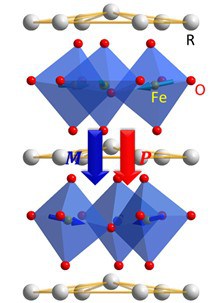Switching the polarity of a magnet using an electric field (magnetoelectric memory [MEM] effect), can be a working principle of the next-generation technology for information processing and storage. Multiferroic materials are promising candidates for the MEM effect, due to the coexistence of electric and magnetic orders. On the other hand, the coexistence of spontaneous electric and magnetic polarizations is rare in known materials, which hinders the application potential of the MEM effect. This article briefly reviews a new family of multiferroic materials-hexagonal rare earth ferrites-that have been demonstrated ferroelectric and ferromagnetic simultaneously by experiments. Both the ferroeletricity and ferromagnetism in hexagonal ferrites originate indirectly from structural distortions, resulting in so-called improper ferroelectric and ferromagnetic orders. Naturally, structural distortions may mediate the coupling between the electric and magnetic polarizations in hexagonal rare earth ferrites, causing the MEM effect, as predicted by theory.
The possible MEM effect in rare earth hexagonal ferrites is particularly useful for information storage and processing because the non-volatile nature of the magnetic polarization avoids the energy cost of constant memory refreshing and a constant flow of current. The polarity of magnets are used to store information, for example, in the hard disk of computers. The information is modified by “writing” the polarity using a magnetic field, which requires a flow of current that costs significant amount of energy. If the polarity can be switched using an electric field (the MEM effect), the energy-efficiency will be greatly improved, because the generation of the electric field intrinsically needs less power than for generating a magnetic field. The fact that the electric field can be easily localized also suggests application in miniaturized devices.
This research was supported in part by Nebraska EPSCoR. Additional co-authors of the paper are Wenbin Wang from Fudan University. Corresponding author for this study is Xiaoshan Xu, [email protected]. The paper can be found in Modern Physics Letters B (MPLB) journal.

